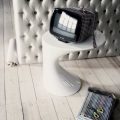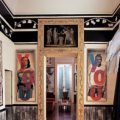Photo: Mikhail Stepanov, Kirill Ovchinnikov.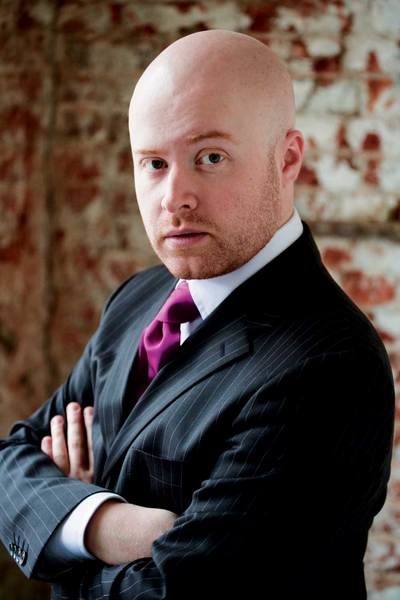 Designer decoratorGraduate of the famous ParsonsSchool of Design Kirill Istomin began his career at the leading New York decorating firm Parish–Hadley (its clients included Brooke Astor, Oscar de la Renta, the Rockefeller family and Jacqueline Kennedy). It was his work with the patriarch of American design Albert Hadley that finally formed Istomin as a professional. After 10 years of working in the USA, Istomin founded the company Kirill Istomin Interior Design & Decoration, specializing in interior design and decor items. Istomin’s designer furniture is produced in the USA, England, Italy, France and Russia. Collections of wallpaper and fabrics have been released based on his drawings. His projects have received prestigious international awards. Rizzoli International Publications (USA) has released a decorator’s handbook with his illustrations — The Pocket Decorator. JOKES AWAY! "If you noticed, everything in this project is quite simple," Kirill begins to comment on his work, while I am amazed to see the pilasters made of monolithic (!) onyx, luxurious lacquered doors with brass inserts (today brass is increasingly imitated with gold paint) and a giant chandelier that "falls" from an incredible height in a crystal cascade, surrounded by incredible stucco molding... "You're kidding! What I didn't notice here was simplicity!" EVERYTHING IS VERY SIMPLE "This interior has a lot of right angles and few curved lines, everything is very strict and laconic, only the ceiling can boast of complex geometry," the decorator continues. - This interior is prestigious, luxurious, but not flashy. It is masculine, that is, very restrained, stingy, but at the same time embodied in rich materials. Take, for example, the floor made of Belgian marble. The value of this rock is not in the beautiful pattern of veins, but in the fact that there are none. This is an absolutely black stone, polished to a mirror state. A floor laid with it looks like a bottomless "ink sea" in which the reflection of the ceiling and stained glass windows drowns."
Designer decoratorGraduate of the famous ParsonsSchool of Design Kirill Istomin began his career at the leading New York decorating firm Parish–Hadley (its clients included Brooke Astor, Oscar de la Renta, the Rockefeller family and Jacqueline Kennedy). It was his work with the patriarch of American design Albert Hadley that finally formed Istomin as a professional. After 10 years of working in the USA, Istomin founded the company Kirill Istomin Interior Design & Decoration, specializing in interior design and decor items. Istomin’s designer furniture is produced in the USA, England, Italy, France and Russia. Collections of wallpaper and fabrics have been released based on his drawings. His projects have received prestigious international awards. Rizzoli International Publications (USA) has released a decorator’s handbook with his illustrations — The Pocket Decorator. JOKES AWAY! "If you noticed, everything in this project is quite simple," Kirill begins to comment on his work, while I am amazed to see the pilasters made of monolithic (!) onyx, luxurious lacquered doors with brass inserts (today brass is increasingly imitated with gold paint) and a giant chandelier that "falls" from an incredible height in a crystal cascade, surrounded by incredible stucco molding... "You're kidding! What I didn't notice here was simplicity!" EVERYTHING IS VERY SIMPLE "This interior has a lot of right angles and few curved lines, everything is very strict and laconic, only the ceiling can boast of complex geometry," the decorator continues. - This interior is prestigious, luxurious, but not flashy. It is masculine, that is, very restrained, stingy, but at the same time embodied in rich materials. Take, for example, the floor made of Belgian marble. The value of this rock is not in the beautiful pattern of veins, but in the fact that there are none. This is an absolutely black stone, polished to a mirror state. A floor laid with it looks like a bottomless "ink sea" in which the reflection of the ceiling and stained glass windows drowns."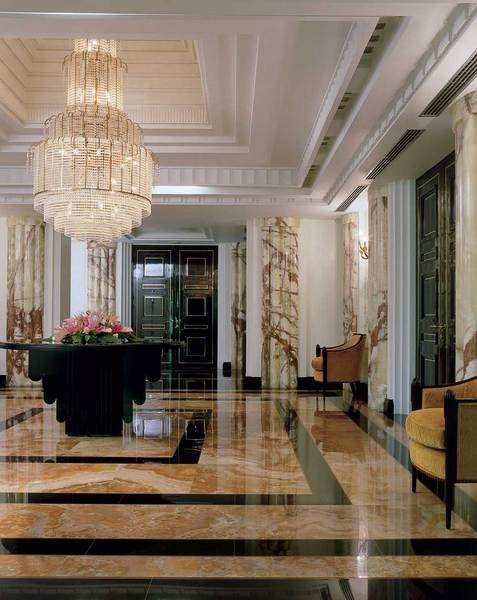 Kirill Istomin
Kirill Istomin



- Photo 1.The hall is decorated with 14 pilasters made of monolithic green onyx. Since the office is on the top floor, a crane had to be used for the installation procedure. The floor is made of black marble and honey onyx and inlaid with brass. The table and doors are made according to Istomin's sketches.
- Photo 2. The walls of the octagonal reception hall are decorated with Venetian plaster. The stained glass windows with metal lattice are based on the ornaments of Edgar Brandt.
- Photo 3. Reception.The cascading plaster ceiling is inspired by the Edgar Brandt pavilion at the Paris exhibition in 1925. The 1950s armchair is upholstered in leather by Maison Fey. Next to it is an exact replica. The antique lamps are from the Sapho Gallery, New York. The rosewood table is designed by Istomin.
- Photo 4. Dining room.Chairs upholstered in silk by Prelle, design 1920s. Marble fireplace inspired by the fireplace by Emile-Jacques Ruhlmann, shown at the exhibition in Paris, 1925. Sconce, design by Istomin. Venetian mirror by John Himmel. Crystal, Baccarat. Silverware, Christofle. Service, Bernadotte.
- Photo 5. Chest of drawers, design by Istomin, with silver handles from Sarie Rare, Paris.
I LOOK AT YOU, AS IN THE MIRROR "In general, in thisThe project is very important reflection game. The abundance of mirrors and polished surfaces creates spatial breakthroughs, increases the size of the premises, makes them ceremonial. The effect of "mirror" is enhanced by paired decor elements - for example, panels of 1920 hanging opposite each other. The geometric configuration of the ceiling is “reflected” in the pattern of brass inlay on the stone floor. Agree, it is spectacular. " Still would. Of course, I agree. WHAT IS IT? Representative office with a total area of 700 square meters. m includes: reception, meeting rooms, dining room, offices and private apartments. Implemented in Moscow for 14 months, including design. The numbers are record! WHAT WAS IT? “The initial data are as follows: the last floor of a modern office building with panoramic windows,” Kirill begins to list, “the height of the ceilings is two-sixty.” - "How are two sixty?" Yes, you're kidding! You have only one chandelier - under three meters. And, frankly speaking, I did not notice the panoramic glazing, ”I slip in again. “As for the ceiling, we managed to“ get through ”to the roof and build a“ nadzheta ”. Thus, ceremonial ceilings with cascading stucco appeared here (behind it, by the way, the wildest number of communications was hidden, to each element of which it was necessary to provide free access). But the most difficult thing was to turn asymmetrical rooms into symmetrical rooms, as the general style of the interior required. It was for this purpose that the panoramic windows had to be partially covered with false walls, due to which the solid glass surface turned into a number of traditional windows. This decision was not reflected on the facade. From the side of the street, everyone hides the curtains. ”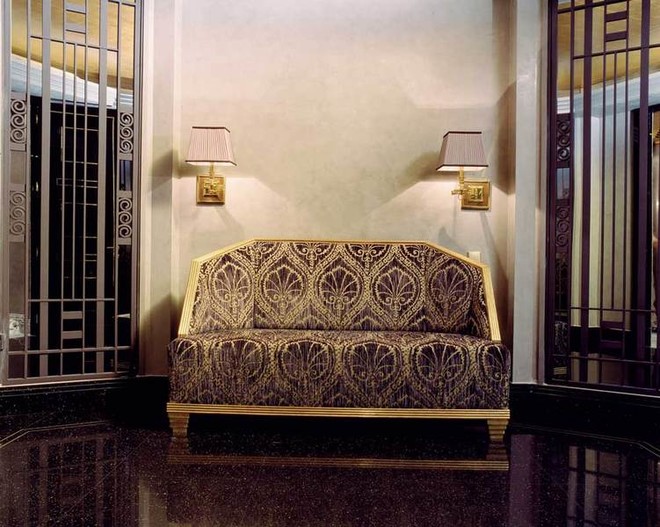

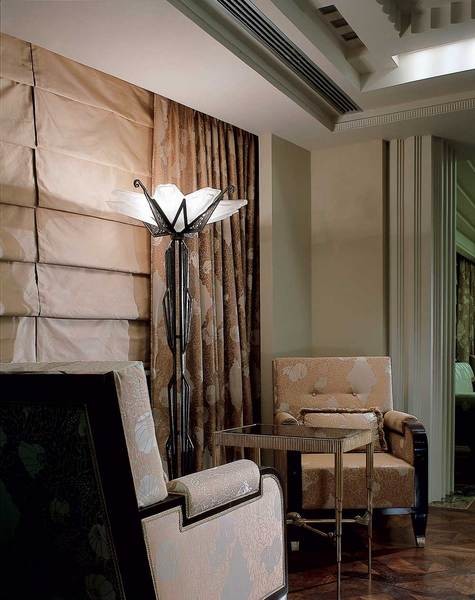


- Photo 1. The rotunda hall. The sofa in Clarence House upholstery was made according to Istomin's sketches. On the ceiling is handmade gold wallpaper; on the wall is a fragment of French fabric from the 1930s.
- Photo 2. Sconce, Lambert, 1925, France.
- Photo 3.Curtains and armchairs, designed by Kirill Istomin, upholstered in silk damask, designed by Emile-Jacques Ruhlmann for Prelle, 1920. Floor lamp, designed by Edgar Brandt, 1930s, France. Gilded chess table by Tis-serant, Paris.
- Photo 4. Sinks and sconces in the toilet room, Devon & Devon; mirrors in black lacquered frames are made according to sketches by Kirill Istomin; wallpaper by Ralph Lauren.
- Photo 5. The sink was custom-made in New York. The antique sconces are Genet et Michon, 1940s, France. The ceiling is covered with hand-made gilded wallpaper. The relief of the ceiling is echoed by the brass inserts of the floor.
SPECIAL EFFECT! There are a lot of special effects like this here.Take the dining room, for example. Its interior will confuse anyone. Contrary to custom, there are two tables here. Reflected in two mirrored walls at the ends, they multiply ad infinitum. And that's not all. Unexpectedly, behind one of the curtains, not a window opens up, but a home theater screen. The interior door, covered with handmade silver Chinese wallpaper, practically merges with the wall, decorated in exactly the same way. It's dizzying! The only thing missing to add excitement is a joke fountain, like in Peterhof. However, such amusements are not in Istomin's style. QUALITY The quality of the work is fantastic. There are a couple of leather chairs in the reception area. One of them is antique, the other is an exact copy. It is made in such a way that only Kirill himself can distinguish the original from the imitation. At least, I couldn't. DIGNIFIED OLD AGE Aged mirrors are also easy to confuse with antique ones. By the way, they were brought from New York. Why from there? Couldn’t they have ordered them in Moscow? “You can’t,” Istomin suddenly says very harshly. “They don’t make aged mirrors in Russia now. Well, they do, but not the way they should. Here, they age the amalgam of a finished mirror. But in America, they first age the glass (treat it with a special solution) and only then apply the amalgam. This is a diametrically opposed approach and, as a consequence, a diametrically opposed result.”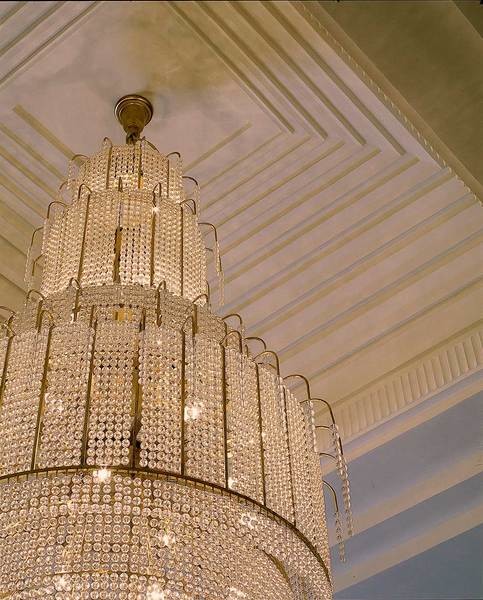

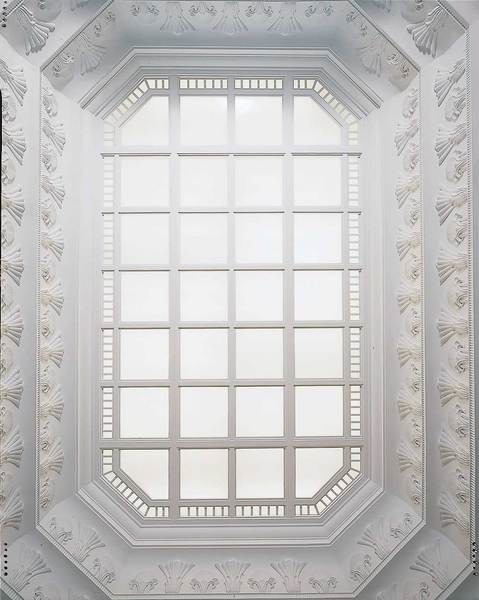
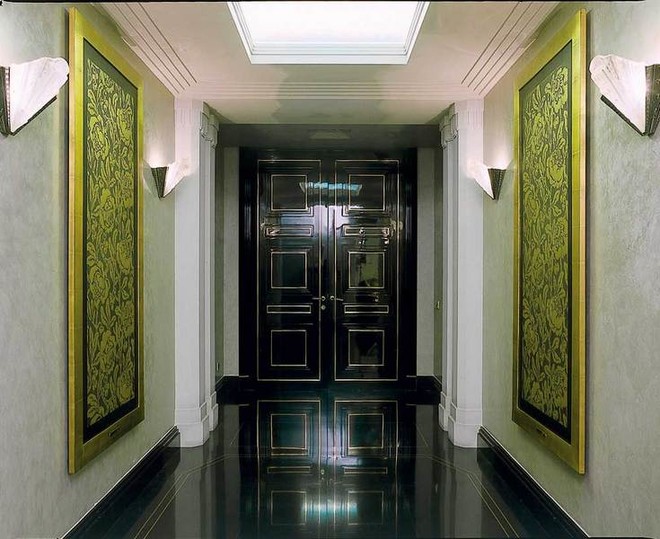
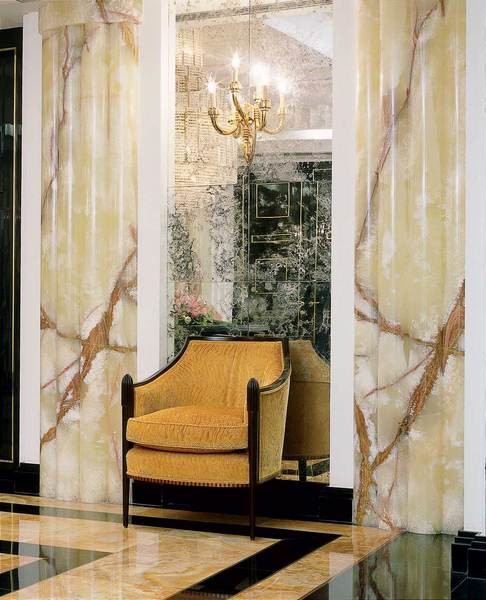
- Photo 1. Remake of the chandelier by Emile-Jacques Ruhlmann, 1928.
- Photo 2. Fragment of a panel from the 1920s, Paris.
- Photo 3. Fluorescent lamps are hidden behind the fake skylight.
- Photo 4. Paired elements support the theme of reflections.
- Photo 5. The French sconces from the 1930s were specially gilded. The chair is upholstered in velvet from Christopher Hyland.
STYLE The project is designed in the Art Deco style.Moreover, this is not a stylization, but a strict adherence to the canons and painstaking work with the original sources. For example, the curtains in the study are made of silk damask woven according to the sketches of the famous Art Deco master Emile-Jacques Ruhlmann. The chairs in the dining room are covered with silk from Prelle (a drawing from the 1920s was found in the archive). The black lacquered doors are a variation on the theme of the works of the architect Albert Speer. The design of the plaster lampshade with stylized lotus flowers brings back memories of the pavilion of Edgar Brandt, which thundered at the World Exhibition in Paris in 1925. In the study there is a rare signed copy of a floor lamp by the same Edgar Brandt. The list of rarities can go on and on. "By the way, the easiest part of the work was the selection of antique items," concludes Istomin. “True, we had to gild some lamps, silver others, and restore others, but it’s not difficult.” In this office, everything is quite simple. Have you noticed?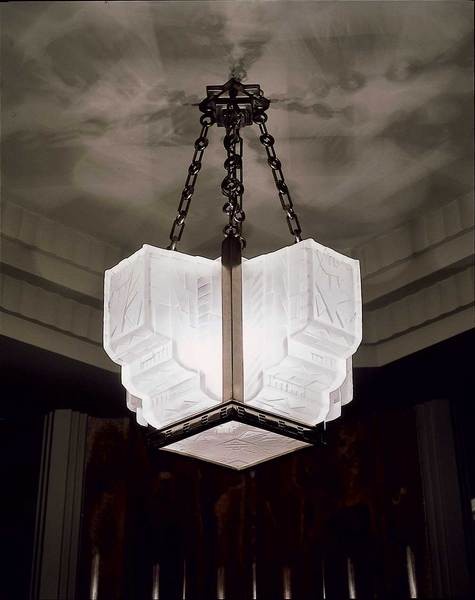 ABOUT THE STYLE The project is designed in the Art Deco style (French:Art Deco) is a movement in art from the 1920s to 1940s. Its official birth date is considered to be 1925, when the International Exhibition of Decorative Arts and Industrial Products was held in Paris. Distinctive features: ethnic and geometric patterns, expensive materials (ivory, crocodile skin, brass, silver, rare types of wood and stone, enamel), zigzag, stepped shapes, chevron motifs and piano keys. It is believed that the luxury of Art Deco is a reaction to the hardships caused by the First World War. However, Art Deco also flourished in America, which had not known war. In the USSR, this style in its pure form never existed; we had Stalin's, or "new empire". Next, you will learn how to braid
ABOUT THE STYLE The project is designed in the Art Deco style (French:Art Deco) is a movement in art from the 1920s to 1940s. Its official birth date is considered to be 1925, when the International Exhibition of Decorative Arts and Industrial Products was held in Paris. Distinctive features: ethnic and geometric patterns, expensive materials (ivory, crocodile skin, brass, silver, rare types of wood and stone, enamel), zigzag, stepped shapes, chevron motifs and piano keys. It is believed that the luxury of Art Deco is a reaction to the hardships caused by the First World War. However, Art Deco also flourished in America, which had not known war. In the USSR, this style in its pure form never existed; we had Stalin's, or "new empire". Next, you will learn how to braid




